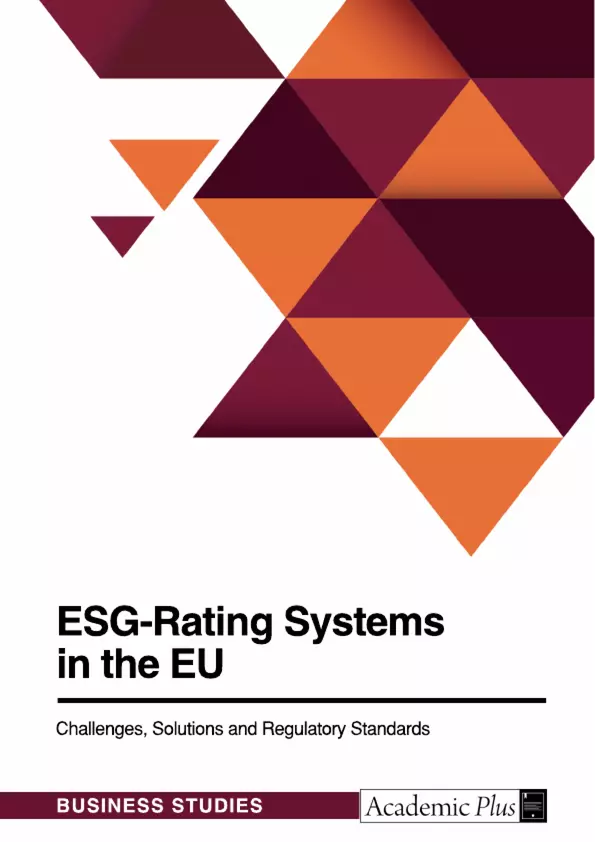This study comprehensively examines the Environmental, Social, and Governance (ESG) rating ecosystem, a critical pillar of sustainable finance. It dives into the complexities and nuances of this ecosystem, highlighting key challenges including transparency deficits, inconsistent standardization, sector and regional comparability issues, inherent biases, conflicts of interest, and data quality concerns. In response, the thesis introduces an innovative regulatory framework, which uniquely synthesizes the European Securities and Markets Authority's (ESMA) recommendations with novel insights from the research. This comprehensive framework prioritizes improved transparency, promotes a new approach to standardized ESG rating methodologies, and calls for adaptive, regular revisions to regulatory mechanisms. It also addresses the critical need for global harmonization of ESG rating principles and improved data standardization. Importantly, the thesis deftly balances the demand for standardization with the necessity to preserve the diversity and adaptability inherent in ESG rating methodologies. By identifying gaps in the current system and proposing these unique solutions, the thesis adds a significant perspective to academic discourse in sustainable finance. It suggests practical approaches towards a more robust, reliable, and efficient ESG rating ecosystem.
Inhaltsverzeichnis (Table of Contents)
- Introduction
- ESG Universe
- Corporate Sustainability
- CSR
- SRI
- ESG
- The ESG Rating Landscape
- Theoretical Foundation of ESG Ratings
- The Demand for ESG Ratings
- The Need
- The Users
- The Use Cases
- Types of ESG Ratings
- Risk vs. Impact
- Forward vs. Backwards-looking approach
- Business Model
- Rating Agencies - an Overview
- Rating Approach Overview
- Identifying Indicators
- Data Collection and Assessment
- Scoring and Evaluation Methods
- ESG Regulation
- Challenges of current ESG ratings
- Transparency of ESG ratings
- ESG Rating Divergence
- Theorization Problem
- Commensurability problem
- Implications of Low Correlation
- Compensation of rating agencies & Conflict of Interests
- Bias
- Size Bias
- Geographic Bias
- Industry Bias
- Data Quality Problem
- Potential Solutions
- Standardizing ESG-Reporting
- Enhanced Transparency and Standardization of ESG ratings
- New Regulatory framework and incentives
Zielsetzung und Themenschwerpunkte (Objectives and Key Themes)
This study provides a thorough examination of the ESG rating ecosystem, a key pillar of sustainable finance. It delves into the intricate challenges within this system, including transparency deficits, inconsistent standardization, and data quality concerns. The work then presents a unique regulatory framework, incorporating insights from research and recommendations from the European Securities and Markets Authority (ESMA), to address these challenges. Key themes and objectives include:- Analyzing the challenges of ESG ratings, including transparency deficits, standardization issues, and data quality concerns.
- Developing a comprehensive regulatory framework to enhance transparency, promote standardized ESG rating methodologies, and address data quality concerns.
- Exploring the need for global harmonization of ESG rating principles and the critical balance between standardization and preserving the adaptability of ESG rating methodologies.
- Identifying gaps in the existing ESG rating system and proposing solutions for a more robust and efficient ecosystem.
- Contributing to academic discourse in sustainable finance through practical and innovative approaches.
Zusammenfassung der Kapitel (Chapter Summaries)
The first chapter introduces the topic of ESG ratings within the context of sustainable finance. Chapter 2 provides a comprehensive overview of the ESG Universe, exploring concepts such as corporate sustainability, Corporate Social Responsibility (CSR), Socially Responsible Investing (SRI), and Environmental, Social, and Governance (ESG) ratings. Chapter 3 dives into the ESG rating landscape, examining its theoretical foundation, the demand for ESG ratings, types of ESG ratings, and a detailed overview of rating agencies and their approaches. This chapter provides an in-depth look at the current state of ESG rating practices. Chapter 4 focuses on ESG regulation, outlining the regulatory landscape and frameworks that govern ESG rating practices. Chapter 5 analyzes the significant challenges faced by current ESG ratings. These challenges include transparency issues, divergence in ratings, conflicts of interest, biases, and data quality problems. Chapter 6 explores potential solutions to address the challenges identified in the previous chapter. These solutions include standardizing ESG reporting, enhancing transparency, and establishing new regulatory frameworks and incentives.Schlüsselwörter (Keywords)
The study focuses on the core concepts of ESG ratings and their role in sustainable finance. Key terms and themes include: Environmental, Social, and Governance (ESG) ratings, sustainable finance, transparency, standardization, data quality, regulatory frameworks, conflicts of interest, bias, and global harmonization. The work also explores concepts like Corporate Social Responsibility (CSR), Socially Responsible Investing (SRI), and the European Securities and Markets Authority (ESMA).- Citar trabajo
- Anonym (Autor), 2023, ESG-Rating Systems in the EU. Challenges, Solutions and Regulatory Standards, Múnich, GRIN Verlag, https://www.grin.com/document/1383492



